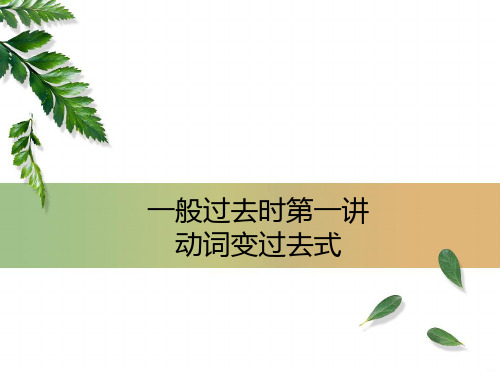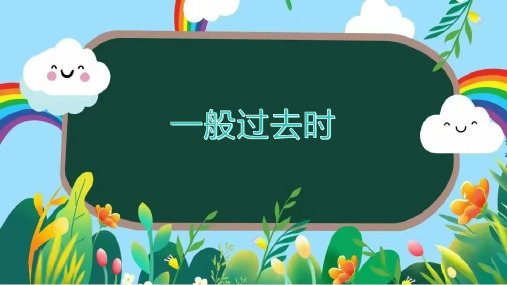一般过去时课件(完整版)
一般过去时PPT获奖课件

Just now 刚刚 Last week 上周 in the past 过去 that day 那天 last year 去年 that year 那年 that month 那个月 just now 刚刚
一般过去时态句式旳构成
陈说句式
动词
肯定式
否定式
I was ….
I was not(wasn’t)….
订正答案 返回练习
一般过去时态练习
把下列句子改成相应时态
1. He usually gets up early in the morning.
But he
got up
late today.
2. She usually works from 8 a.m. to 5 p.m.
But yesterday she worked from 8 a.m. to 6 p.m.
3. stop 6. trip 9. want 12.have e 18.put 21.read
订正答案 返回上页
动词过去式转换练习
答案
1. look looked 4. carry carried 7. call called 10.are were 13.do did 16.say said 19.eat ate
did not(didn’t) work.
There was …. there There were…. be
There was not (wasn’t) …. There were not (weren’t)…问句式
动词
疑问句式和简略答语
第一人称
第二人称
be He /She/it was….
He/She/It was not(wasn’t)….
一般过去时(12张PPT)初中英语专项复习课件

一般过去时 初中英语专项分析
一般现在时 de 应用场景
过
动作行为
去
发
生
曾经
的
存在的状态
识别 标志词 理解 句意
答题技巧
熟练 动词 转换
yesterday last week 3 days ago
动词 过去式
熟练 句型 转换
肯定 否定 疑问
一般 过去时 He played basketball yesterday.
yesterday? Yes, I did. No, I didn’t.
动词 过去式 形态的变化
一般
直接加 ed
二般
以 e 结尾,去 e 加 ed live dance hope use
动词 过去式 形态的变化
三般
重读辅元辅,双写尾字母
stop plan
四般
辅音字母 + y 结尾,把 y 变 i 加 ed cry study worry
标志词
时间状语:last night, yesterday, the day before yesterday last week, some years ago in 1995, the other day, just now, in the past
小学英语时态之 一般过去时讲解课件ppt

一般过去时:
定义: 一般过去时,是表示过去某一时刻或某一段时间内发生的动作或存在
的状态。
标志词: yesterday, just now, …ago, last…, this morning …
结构: 谓语是be动词
谓语是行为动词
肯定句: 主语+ was/were + 其他 否定句: 主语+ was/were + not + 其他 一般疑问句: Was/Were + 主语+其他? 肯定句: 主语+ 动词的过去式 + 其他 否定句: 主语+ didn’t +动词原形 + 其他 一般疑问句:Did + 主语+ 动词原形 +其他?
at the weekends this morning often
usually
last Mid-Autumn Festival
every day three days ago on Mondays
tomorrow a moment ago 14 years ago
找出表示一般过去时的时间副词。
( B) 1. My mother had breakfast and____to work.
A. go B. went C. going D. to go
( A)2. -- How __ your vacation?
-- It was pretty good. A. was B. were C. did D. do
( )3.Each student one picture.
A.draw B. draws C. drawing D.to drawing
一般过去时课件(PPT)课件

用动词的适当时态填空
____ you ________ (remember) to buy the oranges yesterday? 2.Who ________ (play) computer games yesterday. 3.We _____ (go) to the cinema last night. The film _____ (be) very good. 4.What time ____ you ____ (get) to school this morning? 5.Jim ___ (do) a lot yesterday. He ____ (go) shopping and ______ (cook) supper.
lived
ate
had
made
played
cooked
Did
规则变化 1.一般加ed
2.以e结尾加d
3.末尾只有一个辅音字母的重读闭音节词,先双写这个辅音字母,再加ed .
work —
worked
change —
changed
prefer —
preferred
stop —
stopped
study —
didn’t do
Did
find any
How long did
stay
Was
any
Thank you
CLICK HERE TO ADD A TITLE
单击此处添加文本具体内容
演讲人姓名
do/ does
didn’t
did
didn’t watch
一般过去时课件(PPT)

B pictures in the park 1.I ___
Exercises
last weekend. A.take B.took C.was D.draw
A 2. Did you ___football yesterday. A. play B. played C. were D. are
A 3.He always _____me last term. A. helped B. helps C. helping D. help 4.Where did you ___last B Monday? A.went B.go C.do D.did
climbed a mountain
mped
fly kites read a book sing and dance eat good food
swim do am/is are study
flew kites read a book sang and danced ate good food
6. He usually gets ____ (get) up at 6 getting in the morning. Look! He is ______ (get) up now. But yesterday he got (get) up very late, so he ____ went (go) to school late. He was ____ ___ (be) late for school.
动词原形、第三人称单数 动词过去式
They don’t watch TV in the evening. didn’t watch TV last night. They _________
She doesn’t play basketball after school. She _________ didn’t play basketball after school yesterday. Do you go to school on foot every day? go to school on foot yesterday. ___ Did you __ Does he go to school by bus every day?
小学一般过去时教学课件

小学一般过去时教学课件2023-10-26contents •一般过去时的定义和特点•一般过去时的基本用法•一般过去时的常见形式•一般过去时的句型和用法•一般过去时的特殊用法及注意事项目录01一般过去时的定义和特点一般过去时是一种动词时态,表示过去某个时间发生的动作或状态。
定义一般过去时由动词的过去式构成,规则动词的过去式是在动词后加上-ed,例如walk→walked,play→played。
不规则动词则需要单独记忆,例如go→went,do→did。
构成时间指向一般过去时的时间指向是过去,它描述的是过去某个时间发生的动作或状态。
语法结构一般过去时的语法结构是动词的过去式,通过加-ed来构成。
表达方式一般过去时可以用在陈述句、疑问句和否定句中,例如I walkedto school yesterday(我昨天走路去学校)。
02一般过去时的基本用法1表示过去的动作或状态23描述过去发生的动作或状态,例如:昨天我去了公园。
描述已经完成的动作或状态,例如:我已经吃过午饭了。
描述持续到过去的动作或状态,例如:他去年住在北京。
描述过去某人在某事上的经历或经验,例如:我去年去过长城。
描述过去的感受或体验,例如:他昨天很开心。
描述过去对某事物的看法或经历,例如:他以前喜欢看动画片。
表示过去的经历或经验表示过去的比较或对比02描述过去两个时间之间的比较或对比,例如:昨天比前天热。
03描述过去两个地点之间的比较或对比,例如:北京比上海繁华。
03一般过去时的常见形式主语+was/werebe动词的一般过去时形式肯定句形式主语+was not/were not否定句形式Was/Were+主语一般疑问句形式do/does的一般过去时形式肯定句形式:主语+did否定句形式:主语+did not一般疑问句形式:Did+主语肯定句形式:主语+had否定句形式:主语+had not一般疑问句形式:Had+主语have/has的一般过去时形式04一般过去时的句型和用法总结词表示“存在”或“位置”。
英语一般过去时PPT课件

live hope use
lived hoped used
6
3.重读闭音节词, 先双写这个辅音字母,再加—ed
stop plan
stopped planned
7Байду номын сангаас
4. 以“辅音字母+y”结尾的词, 先变“y”为“i”再加—ed
study worry
studied wd orrie
8
不规则动词 过去式的构成
was were did
went had made got
eat
say see stand find
ate
said saw stood found
18
Play Played
19
use used
20
plan planned
21
study studied
22
worry worried
23
stop stopped
一般过去时第一讲 动词变过去式
past no w
futur e
2
动词过去式 的构成
规则动词
regular verbs
不规则动词
irregular verbs
3
规则动词 过去式的构成
1、一般在动词末尾加– ed
look play start
looked played started
5
2、结尾是 e 的动词只加 -- d
否定句: →She didn’t play the violin last night.
肯定句: They swam in the lake yesterday.
否定句: →They didn’t swim in the lake yesterday.
一般过去时公开课优秀课件pptx

课程总结
回顾本节课的重点和难点,鼓 励学生在日常生活中积极运用 一般过去时进行交流
02 一般过去时基本概念
定义及作用
定义
一般过去时表示过去某个时间里 发生的动作或状态。
作用
用于描述过去发生的事情,表达 过去的经历、状态或情感。
构成形式
01
was/were + 动词的过去分词( 用于第一、三人称单数和第二人 称)
03 一般过去时用法详解
表示过去某个时间里发生的动作或状态
动作发生在过去
用一般过去时表示在过去某个时间里 发生的动作或状态,句中常有明确的 时间状语。例如:yesterday, last week, an hour ago等。
状态在过去存在
除了表示动作外,一般过去时还可以 表示过去存在的状态。例如:I was at home yesterday.(我昨天在家。)
与过去进行时的对比
动作进行与完成
一般过去时表示过去某个时间点 完成的动作,而过去进行时强调 过去某个时间点正在进行的动作
。
动词形式
一般过去时使用动词的过去式, 而过去进行时使用“was/were
+ 现在分词”的形式。
语境差异
一般过去时适用于描述单一、完 整的动作,而过去进行时适用于 描述背景、持续的动作或同时发
达。
鼓励同学们多读书、多看电影 、多听音乐,不断拓展自己的 视野和知识面,提高自己的跨 文化交际能力。
期待在下一次的课程中与大家 再次相聚,共同探讨英语学习 的乐趣和奥秘。
THANKS
04
例句:When I was a child, I often played football in the street. ( 当我还是个孩子的时候,我经常在街上踢足球。)
一般过去时(课件)

一般过去时(课件)一般过去时是英语中表达过去某个时间点或时间段发生的动作或状态的一种时态。
在一般过去时中,动词的形式需要根据主语的人称和数进行变化。
一般过去时的句型结构是:主语 + 动词过去式 + 其他。
一、一般过去时的构成1. 规则动词:在动词原形的基础上加上ed。
例如:work → worked, play → played, study → studied。
二、一般过去时的用法1. 表示过去某个时间点发生的动作。
例如:I went to the library yesterday.2. 表示过去某个时间段内发生的动作。
例如:We playedfootball last weekend.3. 表示过去某个时间段内的状态。
例如:She lived in New York for five years.4. 表示过去习惯性动作。
例如:He used to smoke when he was young.三、一般过去时的疑问句和否定句1. 疑问句:将助动词did放在主语之前,动词原形放在助动词之后。
例如:Did you watch the movie last night?2. 否定句:在主语和动词之间加上助动词did,动词原形变成动词的过去式,并在动词过去式前加上not。
例如:I didn't finish my homework yesterday.四、一般过去时的特殊用法1. 过去进行时:表示过去某个时间点正在进行的动作。
例如:What were you doing at 8 o'clock last night?2. 过去完成时:表示在过去某个时间点之前已经完成的动作。
例如:I had finished my work before he came.3. 过去完成进行时:表示在过去某个时间点之前一直在进行的动作。
例如:She had been waiting for two hours when he finally arrived.一般过去时(课件)一般过去时是英语中表达过去某个时间点或时间段发生的动作或状态的一种时态。
初中英语语法-八大时态之一般过去时课件全文

一般过去时疑问句
对于含有是实意动词的句子, 一般疑问句: Did +主语+动词其他…? 特殊疑问句:疑问词+ did(didn’t)+主语+其它? What did you do yesterday? Why did you go there the day before yesterday? Whose father came to see our teacher just now?
Theyw_e_r_e from Japan. I _w_a_s very tired.
4. He is too young to go to school.
Hew_a_s_too young to go to school.
5. You are late for school. Youw_e_r_e late for school.
一般过去时-不含有be动词型
把句子中的动词改为过去式形式。
通常有5种写法。
动词过去式的写法:
01 一般情况词尾加ed 02 e结尾直接在词尾加d 03 辅音加y结尾变y为i加ed 04 重读闭音节结尾双写词尾字母加ed 05 特殊情况
I work in this city. I worked in this city last year.
We are friends.
We weren't friends.
2.当谓语动词是实意动词时,它 与助动词did有关
主语+did + not+ 动词
动词谓语一定要恢复为原形。
一般过去时否定式
主语+did + not+ 动词原型
一般过去时讲解课件(共19张PPT).ppt

否定句
1) 主语+wasn’t/weren’t+表语
He wasn’t a student ten years ago.
2) 主语+didn’t+动词原形+其他
They didn’t have a good time last night.
4.一般过去时的结构
一般疑问句
was为单数; were为复数
一般过去时的结构
4.一般过去时的结构
was为单数; were为复数
肯定句
1) 主语+was/were+表语
He was a student ten years ago.
2) 主语+动词过去式+其他
They had a good time last night.
4.一般过去时的结构
was为单数; were为复数
时间+ago类 in+年份类
yesterday morning;yesterday.... last night; last week...
two days ago in 2023
动词过去式的变化
3.动词过去式的变化 1.直接加ed work--worked look--looked 2.不发音的e结尾,去e加ed hope--hoped like--liked 3.重读的闭音节词,双协结尾字母加ed stop--stopped plan--planned 4.以辅音字母加y结尾,变y为i再加ed study--studied try--tried 5.不规则变化
What did they do last night?
总结与练习
5.总结与练习
一般过去时 1.定义:表示一个过去发生的动作或表示过去存在的状 态 2.标志词:yesterday,last...,....ago, just now..... 3.动词的过去式变化 4.一般过去时的各种句型:
一般过去时课件完整版

误区提示
误区一
误认为一般过去时和现在完成时可以 随意互换使用。实际上,两者在使用 上有所区别,需要根据具体语境选择 合适的时态。
误区二
忽视现在完成时中already, just等副词 的位置。这些副词通常放在助动词 have/has之后,实义动词之前。例如: I have just finished my work.(我刚 刚完成我的工作。)而不是I just have finished my work.
BIG DATA EMPOWERS TO CREATE A NEW
ERA
定义与用法
一般过去时表示过去某个时间里发生的动作或状态。
常和表示过去的时间状语连用,如:yesterday, last week, an hour ago, the other day, in 1982等。
一般过去时也表示过去经常或反复发生的动作,常和often, always等表示频率的时 间状语连用。
两者区别及联系
联系
两者都表示动作发生在过去,但现在完成时强调 过去动作对现在的影响。
在某些情况下,两者可以互换使用,但表达的含 义会有所不同。
使用场景举例
一般过去时
叙述过去连续发生的动作或事件,例如:He opened the door, walked in and sat down.(他打开门,走进去然后 坐下。)
否定句实例分析
I didn't watch TV last night.(我昨 晚没看电视。)
They didn't play football after school.(他们放学后没踢足球。)
She didn't eat breakfast today.(她 今天没吃早餐。)
一般过去时课件(PPT)

1.Lucy did her homework at home. (改否定句) do Lucydidn’t ___ ____ her homework at home. 2.He found some meat in the fridge. (变一般疑问句) Did ___ he find ___ any ____ meat in the fridge? 3.She stayed there for a week. (对划线部分提问) ____ ____ _____ there? How long did____ she stay 4.There was some orange in the cup. (变一般疑问句) Was there ____ any orange in the cup? ____
用动词的适当时态填空
Did you remember 1.____ ________ (remember) to buy the oranges yesterday? 2.Who played ________ (play) computer games yesterday. went 3.We _____ (go) to the cinema last was night. The film _____ (be) very good. did 4.What time ____ you get ____ (get) to school this morning? did 5.Jim ___ (do) a lot yesterday. He went (go) shopping andcooked ____ ______ (cook) supper.
行为动词一般过去时的疑问式
一般过去时的特殊疑问式 疑问词+did+主语+动词原形……? They finished their work at four. B A
英语八大时态PPT课件(详细版)

A
知识导航
种类
一般现在时 一般过去时 一般将来时 现在进行时 现在完成时 过去进行时 过去完成时 过去将来时
构成
do/does did will/shall+动词原形 am/is/are + doing have/has+过去分词 was/were + doing had+过去分词 would/should+动词原 形
A
4
※表示主语所具有的特征、性格、 能力、状态等
She is a middle school student. She looks a little worried. ※某些以here/there开头的句子 中,用一般现在时表正发生的动 作
Here comes the bus.
A
5
※表示将来发生的、时刻表上不改变的事 The train leaves Hunan at five o’clock. ※特殊情况 在时间状语从句和条件状语从句中,若主 句用一般将来时,则从句用一般现在代替 将来。(主将从现)
A
21
四、一般将来时
1、构成 一般将来时态由
“will/shall+动词原形”构成,me to ask Mary for help.
A
22
2、其他表示
※be going to +动词原形:表示 说话人主观的打算或预测。 I am going to look for a job here. It is going to be a fine day for camping tomorrow.
【小试牛刀】 他们昨天这个时候正在吃晚餐。
They were having dinner this time yesterday.
一般过去时公开课优秀课件小学一般过去时优秀课件

在写作中的应用
总结词
在写作中,一般过去时常常用来描述故事、事件或个人经历等过去的事情,使叙述更加 生动和有说服力。
详细描述
在写作中,特别是记叙文、小说、回忆录等文体中,一般过去时被广泛使用。通过使用 一般过去时,作者可以生动地描绘过去的事件、人物和场景,让读者更好地感受到故事 的情感和情节。同时,一般过去时也可以用于描述历史事件和事实,使叙述更加客观和
用于描述已经发生的 事情,例如:昨天我 去了公园。
一般过去时的基本形式
01
02
03
04
动词形式变化
规则动词和不规则动词的过去 式形式。
时间状语
通常与表示过去时间的状语连 用,如yesterday, last week
等。
否定形式
在动词前加助动词did not (didn't) 或 didn。
疑问句形式
感谢您的观看
THANKS
填空练习
提供缺少动词的句子,让 学生填写正确的过去时态 动词。
选择题
列出多个动词,让学生从 中选择正确的过去时态形 式。
改错题
提供含有错误过去时态的 句子,让学生进行纠正。
语境练习
情境对话
设置一个特定的情境,让 学生使用过去时态进行对 话。
故事编写
让学生编写一个以过去时 态为主的故事,强调时态 的正确使用。
一般过去时公开课优 秀课件
汇报人:可编辑
2023-12-24
目录
CONTENTS
• 一般过去时的定义 • 一般过去时的用法 • 一般过去时的常见错误 • 一般过去时的练习 • 一般过去时的实际应用
01 一般过去时的定义
什么是一般过去时
一种描述过去事件或 状态的时态。
- 1、下载文档前请自行甄别文档内容的完整性,平台不提供额外的编辑、内容补充、找答案等附加服务。
- 2、"仅部分预览"的文档,不可在线预览部分如存在完整性等问题,可反馈申请退款(可完整预览的文档不适用该条件!)。
- 3、如文档侵犯您的权益,请联系客服反馈,我们会尽快为您处理(人工客服工作时间:9:00-18:30)。
所有时态都是通过
动词
变化来表现的
1.定义: (用法一) 一般过去时态表示过去某个时间发生的动
作或存在的状态,常和表示过去的时间状语连用; 例句:I got up at 7:00 yesterday.
My father was at work yesterday afternoon
(用法二) 也表示过去经常或反复发生的动作,常和 表示频度的时间状语连用。
He _d_i_d_ some reading last night.
动词原形、第三人称单数 动词过去式
They don’t watch TV in the evening. They _di_d_n_’t_w__at_c_h TV last night.
She doesn’t play basketball after school.
clean —cleaned
2.以e结尾加d change — changed
use — used live — lived arrive — arrived
3.末尾只有一个辅音字母的重读闭 音节词,先双写这个辅音字母,再 加ed .
stop — stopped
plan — planned
trip — tripped
ago
2.与last 连用
time night
last
week month
term
3.与yesterday 连用:Monday
morning
yesterday afternoon
evening
the day before yesterday
4.其他时间状语:
just now in the old days in 1980 the other day at that time once upon a time
3、一般过去时的构成
Please look at the sentences
我今年12岁. I _a_m_ 12 years old this year.
我去年11岁. I _w_a_s_ 11 years old last year.
他现在在北京。 He __is__ in Beijing now. 他昨天在上海。 He _w_a_s_ in Shanghai yesterday.
prefer — preferred
4.以辅音字母加y 结尾的词,先 改 y为 i,再加ed
study — studied fly — flied
carry — carried
cry — cried
不规则变化.
1)-eep结尾,过去式变成-ept形式 keep — kept
sweep — swept sleep — slept
例句: He always went to work by bus last year. (含有频度副词: often always 等,但主要还是 含有过去时间状语)
.
2、一般过去时的判断标志: 明确的过去时间状语
1.与ago 连用: two minutes three hours five days one week six months four years
_D_id_ he _g_o_to school by bus yesterday?
don’t/ doesn’t
didn’t
do/ does
did
谓语构成
1.动词 be
was , were
2.动词 have, has had
3.助动词do, does did
4.行为动词用过去式
一般过去时以动词的过去式来表示,
burn — burnt learn — learnt
6).-eak结尾,过去式变成-oke形式
speak — spoke break — broke 7).把动词原形中的i改为a,变成过去式
他们今天在中国。 They _a_r_e_ in China today.
他们昨天在日本。 They _w_e_re_ in Japan yesterday.
am/ is are
was were
每天,早餐我吃鸡蛋和牛奶。 I h_a_v_e_ eggs and milk for breakfast 30 every morning. I _g_ot_ up at 9:00 last Sunday.
He plays football every afternoon. He _pl_a_y_ed_ basketball yesterday afternoon.
He does his homework every evening.
She _d_id_n_’t__pl_a_y_ basketball after school yesterday.
Do you go to school on foot every day? _D_id_ you _g_o to school on foot yesterday.
Does he go to school by bus every day?
2).-ell结尾,过去式变成-old形式
sell — sold tell — told 3).-end结尾,过去式变成-ent形式
lend — lent spend — spent send — sent 4).-ay结尾,过去式变成-aid形式 say — said pay — paid
5).-n结尾,过去式变成-nt形式
昨天,早餐我吃面条。 I _h_a_d_ noodles for breakfast yesterday morning.
他每天都吃水果。
He __h_as__ fruit every day.
昨天他吃了3个苹果。
He _h_a_d__ 3 apples yesterday.
have/ has
had
没有人称和数的变化.(was,were除外)
I went to school yesterday.
They went to school yesterday.
一般过去时的谓语构成:由动词 的过去式构成
规则变化
1.一般加ed start —started
look — looked
play — played
